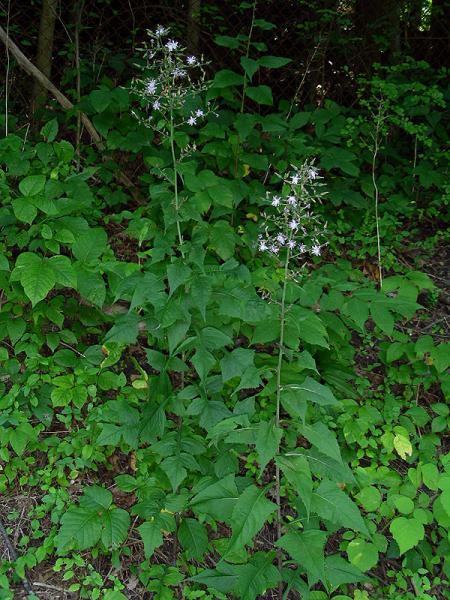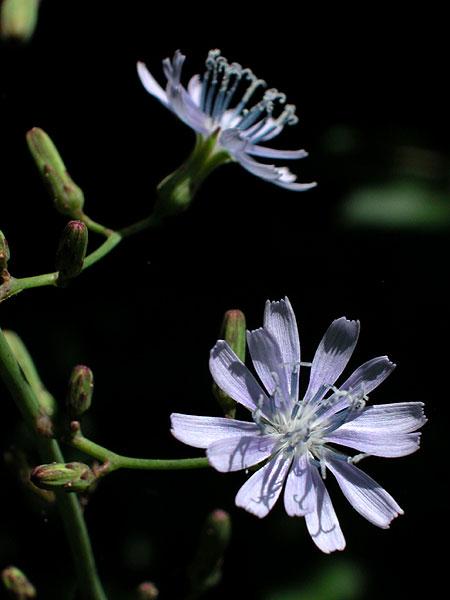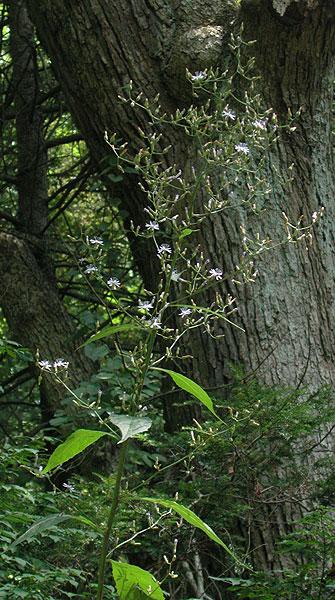Woodland Lettuce
Lactuca floridana (L.) Gaertn.
- Class
- Dicotyledoneae (Dicots)
- Family
- Asteraceae (Aster Family)
- State Protection
- Endangered
Listed as Endangered by New York State: in imminent danger of extirpation in New York. For animals, taking, importation, transportation, or possession is prohibited, except under license or permit. For plants, removal or damage without the consent of the landowner is prohibited.
- Federal Protection
- Not Listed
- State Conservation Status Rank
- S1
Critically Imperiled in New York - Especially vulnerable to disappearing from New York due to extreme rarity or other factors; typically 5 or fewer populations or locations in New York, very few individuals, very restricted range, very few remaining acres (or miles of stream), and/or very steep declines.
- Global Conservation Status Rank
- G5
Secure globally - Common in the world; widespread and abundant (but may be rare in some parts of its range).
Summary
Did you know?
This species and the common tall blue lettuce, Lactuca biennis, are the only species of wild lettuce with fruit hairs (pappus) in double rings. Lactuca means milk in Latin and refers to the milky sap of this genus (Fernald 1950).
State Ranking Justification
There is only one existing population with less than 50 plants. There are records from 1851 and 1924 that remain to be checked to see if they still exist.
Short-term Trends
More survey work is needed to understand short-term trends.
Long-term Trends
This plant has always been very rare in New York and continues to exist at low levels.
Conservation and Management
Threats
One population is near a path and may be threatened by improper path management or direct trampling.
Conservation Strategies and Management Practices
Plant should be monitored occasionally to see if they are being directly affected by park visitation.
Research Needs
Herbarium work is needed to determine if all specimens are correctly identified. Propagation work should be done to see if the present population could be augmented. We would also like to know what limits its growth in New York.
Habitat
Habitat
The plants occur in oak-hickory forest on rich, moist soil. A historical specimen was from hilly, rich woods (New York Natural Heritage Program 2012). Rich woods, thickets and openings (Fernald 1970). Thickets, woods, and moist, open places (Gleason & Cronquist 1991).
Associated Ecological Communities
- Appalachian oak-hickory forest
(guide)
A hardwood forest that occurs on well-drained sites, usually on ridgetops, upper slopes, or south- and west-facing slopes. The soils are usually loams or sandy loams. This is a broadly defined forest community with several regional and edaphic variants. The dominant trees include red oak, white oak, and/or black oak. Mixed with the oaks, usually at lower densities, are pignut, shagbark, and/or sweet pignut hickory.
Associated Species
- Carya cordiformis (bitternut hickory)
- Carya glabra (pignut hickory)
- Celastrus orbiculatus (Oriental bittersweet)
- Eurybia divaricata (white wood-aster)
- Fraxinus americana (white ash)
- Geum
- Juglans nigra (black walnut)
- Maianthemum racemosum
- Parthenocissus quinquefolius
- Persicaria virginiana (jumpseed)
- Prunus serotina
- Rosa multiflora (multiflora rose)
- Rubus
- Solidago rugosa
Range
New York State Distribution
This wildflower was known from the Hudson Valley from Dutchess County to the Bronx and also in Nassau County on Long Island. There is an unsubstantiated report from Chemung County. It is currently known only in the Bronx.
Global Distribution
This herb is common in the eastern United States east of the short grass prairie. It is less common in the northern tier of states from New York to Minnesota and in the provinces of Manitoba and Ontario.
Identification Comments
General Description
This plant is a tall annual or perennial wildflower that grows up to 2 meters tall. The leaf blades only have hairs along the main veins beneath and they vary from elliptic with a few teeth to very lobed or even these few leaflets at the base. The 11-17 (sometimes up to 25) flowers are bluish, or white in a large open inflorescence. The pappus is bright white. The achenes are 4-6 mm long, gray-black and mottled and several-nerved on each face.. The outer fruits are often distinctly thick-beaked, the inner are beakless.
Identifying Characteristics
Distinguishing characteristics: leaves lyrate or runcinate-pinnatifid; flowers bluish, or white; inflorescence ample, open-paniculiform; pappus bright white; achenes gray-black or fuscous, mottled, the outer often distinctly thick-beaked, the inner beakless. Best life stage for ID: in fruit. Characteristics needed to ID: mature achenes.
Best Life Stage for Proper Identification
The best time to identify this species is when it is in fruit.
Similar Species
Lactuca biennis has a light brown pappus and elongate, narrowly paniculiform inflorescence.
Best Time to See
The plants flower in July and August and mature fruits develop August through mid-October.
- Flowering
- Fruiting
The time of year you would expect to find Woodland Lettuce flowering and fruiting in New York.
Woodland Lettuce Images
Taxonomy
Woodland Lettuce
Lactuca floridana (L.) Gaertn.
- Kingdom Plantae
- Phylum Anthophyta
- Class Dicotyledoneae
(Dicots)
- Order Asterales
- Family Asteraceae (Aster Family)
- Order Asterales
- Class Dicotyledoneae
(Dicots)
- Phylum Anthophyta
Additional Common Names
- False Lettuce
Synonyms
- Lactuca floridana var. villosa (Jacq.) Cronq.
Additional Resources
References
Fernald, M.L. 1950. Gray's manual of botany. 8th edition. D. Van Nostrand, New York. 1632 pp.
Flora of North America Editorial Committee. 2006. Flora of North America North of Mexico. Vol. 19. Magnoliophyta: Asteridae, Part 6: Asteraceae, part 1. Oxford Univ. Press, New York. xxiv + 579 pp.
Gleason, Henry A. and A. Cronquist. 1991. Manual of Vascular Plants of Northeastern United States and Adjacent Canada. The New York Botanical Garden, Bronx, New York. 910 pp.
Holmgren, Noel. 1998. The Illustrated Companion to Gleason and Cronquist's Manual. Illustrations of the Vascular Plants of Northeastern United States and Adjacent Canada. The New York Botanical Garden, Bronx, New York.
Mitchell, Richard S. and Gordon C. Tucker. 1997. Revised Checklist of New York State Plants. Contributions to a Flora of New York State. Checklist IV. Bulletin No. 490. New York State Museum. Albany, NY. 400 pp.
New York Natural Heritage Program. 2010. Biotics database. New York Natural Heritage Program. New York State Department of Environmental Conservation. Albany, NY.
New York Natural Heritage Program. 2024. New York Natural Heritage Program Databases. Albany, NY.
Reschke, Carol. 1990. Ecological communities of New York State. New York Natural Heritage Program, New York State Department of Environmental Conservation. Latham, NY. 96 pp. plus xi.
Weldy, T. and D. Werier. 2010. New York flora atlas. [S.M. Landry, K.N. Campbell, and L.D. Mabe (original application development), Florida Center for Community Design and Research http://www.fccdr.usf.edu/. University of South Florida http://www.usf.edu/]. New York Flora Association http://newyork.plantatlas.usf.edu/, Albany, New York
Links
About This Guide
This guide was authored by: Stephen M. Young
Information for this guide was last updated on: September 20, 2012
Please cite this page as:
New York Natural Heritage Program. 2024.
Online Conservation Guide for
Lactuca floridana.
Available from: https://guides.nynhp.org/false-lettuce/.
Accessed July 27, 2024.


